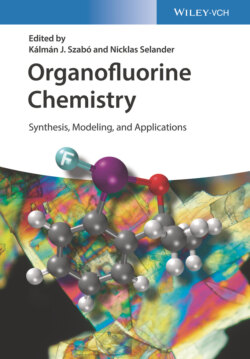Читать книгу Organofluorine Chemistry - Группа авторов - Страница 30
2.2.4 Photochemical Reactions
ОглавлениеIn 1993, Mallouk and Lai developed a photochemical approach for trifluoromethylation with silver trifluoroacetate, in which TiO2 was used as a photocatalyst for trifluoromethylation of aromatic compounds (Scheme 2.26a) [56]. The TiO2 catalyst promotes photolysis of trifluoroacetate to generate trifluoromethyl radical. In 2017, Su, Li, and coworkers developed a new catalytic system using Rh‐modified TiO2 nanoparticles for photochemical trifluoromethylation with trifluoroacetic acid in the presence of Na2S2O8 as an additive (Scheme 2.26b) [57].
Scheme 2.26 Photochemical trifluoromethylation using TiO2.
Not only simple arenes but also N‐containing heteroarenes were available, affording the desired products in modest to good yields. Very recently, Hosseini‐Sarvari and Bazyar achieved a photocatalytic trifluoromethylation using sodium trifluoroacetate under blue LED irradiation in the presence of Au‐modified ZnO catalyst (Au@ZnO core–shell nanoparticles) (Scheme 2.27) [58]. Au@ZnO could catalyze not only aromatic trifluoromethylation but also coupling‐type trifluoromethylations of aryl halides as well as boronic acids under appropriate conditions.
Scheme 2.27 Au@ZnO‐catalyzed photochemical trifluoromethylations.
Qing and coworkers developed a homogeneous photocatalytic system for hydro‐aryldifluoromethylation of alkenes with difluoroarylacetic acids by using an iridium photoredox catalyst, Ir[dF(CF3)ppy]2(dtbpy)]BF4 (Scheme 2.28) [59]. Methoxybenziodozole (BIOMe) as an additive plays a crucial role in the catalytic cycle; it accelerates photolysis of the carboxylic acid by forming a hypervalent iodine intermediate possessing carboxylate as a ligand, and promotes turnover of the photoredox catalytic cycle by oxidizing excited‐state IrIII* to IrIV species. The CF3 radical generated by photolysis reacts with alkene and the resulting alkyl radical affords the hydro‐aryldifluoromethylated product via hydrogen abstraction from N‐methylpyrrolidone (NMP).
Zhu and coworkers also developed a photocatalytic fluoroalkylation of alkenes bearing benzaldehyde or propenal functionalities on the side chain with fluorinated carboxylic acids by using the combination of Ir‐catalyst and the oxidant PhI(OAc)2 (Scheme 2.29) [60]. Cyclic ketones bearing fluoroalkyl groups, such as CF2Ar, CF2H, and CF2Me groups, were obtained up to 90% yield.
Scheme 2.28 Ir‐photocatalyzed aryldifluoromethylation.
Scheme 2.29 Carbo and heterocyclic ketone synthesis by Ir‐photocatalyzed carbo‐fluoroalkylation of alkenyl aldehydes.
Recently, Gouverneur and coworkers developed a photocatalyst‐free hydro‐difluoromethylation [61a] as well as ‐chlorofluoromethylation [61b] of simple alkenes under blue LED irradiation (Scheme 2.30); the reactions were accomplished by the use of a combination of fluorine‐containing carboxylic acid and iodobenzene diacetate.
Scheme 2.30 Metal‐free photochemical hydro‐fluoroalkylations.
